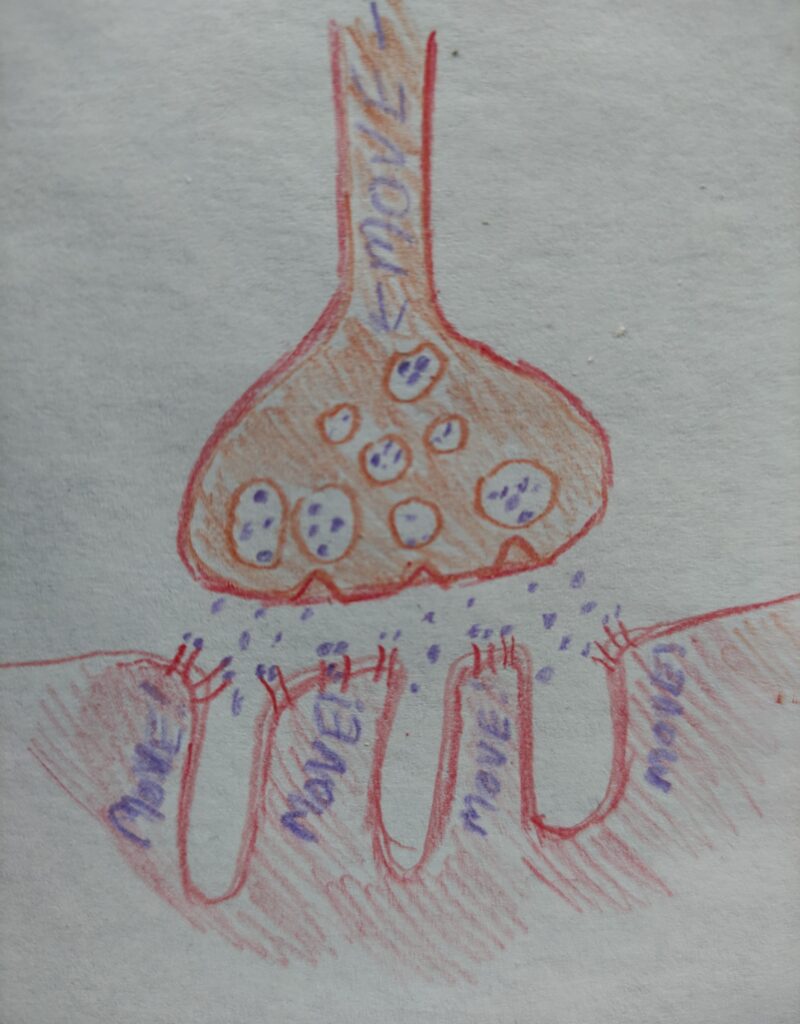My STEAM project is on the neuromuscular autoimmune disorder myasthenia gravis. This relates to the course objective, “Describe how a muscle contraction is induced”. The first image is of a neuromuscular junction of a healthy individual, while the second is of an individual with myasthenia gravis.
Typical NMJ
An action potential (purple lettering: move) is initiated by a motor neuron and arrives at the axon terminal. Vesicles release acetylcholine (represented by purple dots) into the synaptic gap. Acetylcholine binds to acetylcholine receptors (red lines on the postsynaptic side) on the motor end-plate, beginning the depolarization of the muscle fiber and propagation of the action potential into the muscle.

Myasthenic NMJ
An action potential is initiated by a motor neuron and arrives at the axon terminal. Vesicles release acetylcholine into the synaptic gap. The junctional folds of the postsynaptic membrane have been simplified by antibodies (Y shaped, and pictured in blue). Antibodies also bind to acetylcholine receptors, blocking acetylcholine from binding with the receptors. Ability for an action potential to consistently enter the muscle fiber is reduced.


For Abigail’s STEAM Project, she decided to focus on the autoimmune disorder of myasthenia gravis. The focus of the project and course objective she explored further on is “describe how a muscle contraction is induced” from Unit 5: Muscles. Her project is an illustration which demonstrations the movement of the acetylcholine (ACh) binding to receptors in two models. The first is the healthy model which shows the action potential moving down the axon terminal and released by the vesicle and into the synaptic gap where it will the being to the ACh receptors (AChR). The second model shows how the AChR may be blocked by antibodies the body has sent as a result of misreading and then targeting the ion channels and proteins at the neuromuscular junction (NMJ) and not allowing binding to occur completely or to its full extent. Overall the project shows with the typical NMJ has the ACh flowing without issue and how the Myasthenic NMJ having a blocked AChR has a reduced flow that interferes with the transmission of action potentials to the muscle, and will then lead to impaired muscular function. This impacts how a muscle contracts as the action potential being dispatched into the release of ACh causes the motor-end-plate of the AChR to react and create muscle contractions, but with the AChR being blocked then the motor-end-plate is unable to consistently receive the ACh, the action potential cannot be translated or allow for depolarization in the membrane potential of the muscle fiber and continue the process that becomes the muscle contraction. Within her essay Abigail discusses important factors to consider when discussing MG, such as the prevalence, prognosis, and diagnosis outcomes, as well as treatments and outcomes for the disorder with positive regard for the success of certain trials.